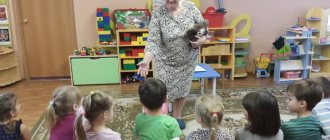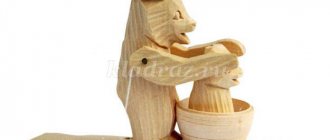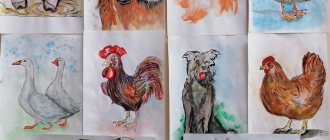Summary of a lesson on familiarization with the outside world in the middle group “Berries and Fruits”.
Summary of a lesson on familiarization with the outside world
in the middle group “Berries - fruits”
Program content: deepen knowledge and understanding on the topic of fruits and berries. Learn to write a descriptive story. Learn to distinguish fruits by appearance. Learn to distinguish berries by appearance.
Materials: pictures depicting fruits and berries, a bi-ba-bo doll Masha, 2 baskets, a green carpet, small balls according to the number of children, a poster “Wild and garden berries.”
Connection with other classes and activities: observation, speech development, cognitive development, outdoor play.
Children enter a group where the teacher has previously laid out pictures of fruits and berries on the floor. The teacher puts on the bi-ba-bo doll Masha. Masha is crying. The teacher asks what's the matter. She says that she was carrying a basket of fruits and a basket of berries. She stumbled, fell, spilled everything, and now she can’t put fruits and berries into baskets. Invite the children to collect the pictures and put them in two baskets. Each child chooses one picture, tells what it shows and puts it in the correct basket. After all the pictures are laid out, Masha asks, how did you understand which pictures have fruits and which ones have berries? After all, both of them are sweet. Children answer that the fruit is larger. When they are eaten, they must be bitten or cut. And the berries are small. You can eat them whole or even several berries at the same time.
Now let’s warm up a little and pick berries in the clearing. (Spread a green carpet on the floor and lay out small balls. These will be berries in the clearing. While the music is playing, children walk around the clearing. As soon as the music has died down, they collect berries. There should be balls according to the number of children. Now the teacher invites each child to tell about their berry It is advisable not to repeat yourself.
Guys, you have collected all the berries. What kind of poster is this hanging here? Children come to the board where the poster “Forest and garden berries” hangs. Collective consideration and conversation on the topic “How wild berries differ from garden berries.”
Masha says that today, together with the guys, she learned a lot of new things and learned to distinguish fruits and berries, learned new names. And now she has come up with a game and invites the kids to play it. Masha will show a picture of a fruit, and the children must name the juice that is made from it.
Masha says goodbye to the children and leaves. And the teacher invites the children to wash their hands and go drink juice. And the guys must guess which one themselves by looking at the juice boxes.
Summary of a lesson on speech development in the middle group on the topic “Description of fruits.”
Lesson summary on speech development
in the middle group on the topic “Description of fruits.”
Educational field Speech development
The topic of the lesson is “Description of fruits.”
Implementation of the program content in educational areas : “Speech development”, “Artistic and aesthetic development”, “Cognitive development”, “Social and communicative development”.
Types of children's activities : gaming, communicative, cognitive and research.
Objectives: learn to compare and describe fruits.
Program tasks:
Educational: continue learning about fruits by solving riddles; learn to describe fruits by color, shape, size; learn to use adjectives in speech, forming them from nouns.
Developing: develop, knows how to maintain a conversation, expresses his point of view, logical thinking, attention.
Educational: To cultivate a caring and loving attitude towards nature, which has generously endowed us with its riches; develop the ability to listen to each other;
Vocabulary work: fruit, fruity, orange, lemon, cherry, plum, peach,
Preliminary work: looking at pictures of fruits, the game “What grows where”, conversation on the topic “Fruits”, “Fruit preparations”.
Materials and equipment : Hedgehog and Little Fox, envelope, pictures of fruits, ball, sheets of paper with images of ovals and circles; two pictures of fruits to find the differences, replicas of fruits, fresh fruits.
Contents of organized children's activities
1. Organizational moment.
Educator: Good afternoon! Happy hour!
I'm very glad to see you.
You turn to each other and smile.
And sit down quietly.
Educator: Guys, who came to us? (Hedgehog and Little Fox are sitting on chairs near the board, holding an envelope)
Children: Hedgehog and little fox
Educator: Yes, these are our friends. Guys, look, they are unusual today, Hedgehog has prepared something for us in an envelope. Let's open it and read it. (Takes the envelope and opens it)
Guys, our friends invite us to play and solve riddles.
Children: stand in a semicircle and look at the board.
2. Guessing riddles. Description of fruits by color and shape.
1.Round, ruddy
It grows on a branch
Adults love him
And little children (apple)
(hang a picture of an apple on the board and the children must talk about it).
Educator: What is this? What color is the apple? What shape? What size is an apple?
Children: The apple is red, round in shape. The apple is big.
2.With orange skin,
Looks like a ball
But the center is not empty,
And juicy and tasty. (Orange)
(There is a picture of an orange on the board).
Educator: What is this? What color is the orange? What shape? What size? Do you think an orange is sweet or sour?
Children: Orange, round in shape...
3.It's almost like an orange
Thick skinned, juicy,
There is only one drawback -
Very, very sour (lemon)
(there is a picture of a lemon on the board).
Educator: What is this? What color is lemon? What shape is it? What size is a lemon?
Children: answer questions
4.Blue uniform, white lining,
It's sweet in the middle. (Plum.)
(on the board there is a picture of a plum).
Educator: What is this? What color is plum? What shape? What size is the plum?
Children: answer questions
5. A whole herd of horses on one leash. (Grape.)
Educator: What is this? What color are grapes? What shape? What size are the grapes?
Children: answer questions
Educator: I’m sitting on a tree, round like a ball,
Red as blood, sweet as honey. (Cherry.)
Educator: What is this? What color are cherries? What shape? What size is the cherry?
Children: Cherry is red, round in shape. Small cherry.
Educator: Well done, guys. All the riddles were solved.
Educator: Guys, how can you call an apple, orange, lemon in one word? What is this? Children: fruit.
Educator: Guys, where do fruits grow?
Children: in the trees
Educator: What are the names of the trees on which fruits grow?
Children: fruit
Educator: Where do fruit trees grow?
Children: in the garden.
Educator: What is the name of a garden in which there are many fruit trees?
Children: orchard
Educator: Well done! The Hedgehog and the Little Fox are also happy with you.
Physical school
Educator: Let's rest a little. Leave the tables and come to me. Stand in a circle. And we will put the Hedgehog and the Little Fox in the center of the circle.
Children: Go out to the teacher’s carpet and stand in a circle.
“Yesterday we walked in the garden, They walk in a circle, holding hands.
We planted currants. They depict how they dig a hole and plant a bush in it.
We whitened the apple tree with lime and whitewash. Move your right hand up and down.
We fixed the fence. Simulates hitting with a hammer.
We started a conversation: They stand facing in a circle
- Tell me, our gardener,
What will you give us as a reward? One finger is bent for each name.
I will give you lilac plums and honey pears as a reward,
The largest ripe apples, They stretch their hands forward.
A whole kilogram of cherries
This is what I will give you as a reward.
A whole kilogram of cherries, that's what I'll give you as a reward.
3. Game “Which one? Which?".
Educator: And now we will sit down on the palace. The Hedgehog and the Little Fox will roll the ball for you and name the color and object in the singular, for example, yellow pear, and you must say how it will be in the plural - yellow pears..
Educator on behalf of the Hedgehog and the Little Fox: orange orange
Child: orange oranges
4. Coloring.
Teacher: gives each child a sheet of paper on which ovals and circles are depicted.
Children: according to the teacher’s instructions, paint the figures, then determine what the painted figure looks like.
Instructions: Color the shape in the first lower right corner green (apple); in the upper left corner - yellow (lemon), in the middle - orange (orange).
5. Game " Treats".
Educator: Guys, but E. and L. don’t know why people grow so many fruits. After all, if you don’t eat them all at once, what will they do?
Children: they will spoil, they will not taste good
Educator: Let's tell our friends how to store fruit.
Children: boil, dry, freeze
Educator: What can you cook from fruits?
Children: jam, compote, juice, marmalade
Educator: I am the presenter, I give you a piece of fruit and ask: “What kind of orange juice?”
Child: orange
Educator: “What kind of peach juice?”
Child: peach
Educator: “What kind of apple juice?”
Child: apple
Educator: “What kind of pear juice?”, “What kind of banana juice?”, “What kind of lemon juice?” (you need to play with each child)).
6. Comparison of images.
Teacher: shows a picture on the board
Children compare two pictures, find and name the differences.
7. Game “Forgetful buyer”.
A “seller” and a “buyer” are selected. Models or pictures of fruits are laid out on the table. The “buyer” says that he forgot the name of the item he wants to buy. The “seller” asks to describe the item: color, shape, taste, what it feels like, what it’s like inside. Based on the description, the “seller” guesses the fruit that the “buyer” wants to buy.
8. Reflection. Game "Define the taste."
Educator: Hedgehog and Little Fox brought us treats. Now you and I will put blindfolds on our eyes, go up to the table and taste what kind of fruit it is? Well, the Hedgehog and the Little Fox will see if you complete the task correctly or not. Children: close their eyes and take the prepared fruits into their mouths and guess what they ate.
Educator: Well done! It's time for the Hedgehog and the Little Fox to return to the forest, let's say goodbye to them. Goodbye, guys..
Children: Goodbye
Summary of GCD on the topic “Fruits” middle group
Summary of GCD on the topic “Fruits” in the middle group
Target:
— consolidate children’s knowledge on the topic “Fruits”
Objectives:
-
to enhance children’s knowledge about the places where fruits grow and their beneficial properties;
-
develop memory, thinking, attention, oral speech; — clarify the idea of the benefits of fruits for human health; - cultivate a caring attitude towards nature.
Equipment:
— demonstration material: pictures of vegetables and fruits, dummies, basket;
Preliminary work
: - reading fiction on the topic; - observation in nature
Progress:
Educator:
- Today you and I will go to grandma’s garden and find out what grows there.
- Turn around and find yourself in grandma’s garden! Children turn around and, together with the teacher, approach a magnetic board with a picture of an orchard.
"Guess the riddle and find the answer"
Educator:
— Guys, look how many trees there are in grandma’s garden.
Do you know what grandma grows? Our favorite riddles will help us! So, the first riddle: - The fruit looks like a tumbler, wears a yellow shirt. Having broken the silence in the garden, it fell from the tree... (pear)
- It looks like a red ball, Only it doesn’t rush at a gallop. It contains a useful vitamin - This is a ripe... (orange)
— Yellow citrus fruit grows in sunny countries. And it tastes sour. What is his name?... (lemon)
— Children know this fruit, monkeys love to eat it. He comes from hot countries. Grows high... (banana)
- Round, ruddy, I grow on a branch. Adults and little children love me (apple)
— It's green and big
— Balls hanging on the branches, Turned blue from the heat (plum)
- Pear, apple, banana, Pineapple from hot countries. These delicious products are collectively called... (fruits)
Educator:
— Fruit trees in the garden require a lot of attention and care. They dig up the ground around the tree, protect the trees from parasites, and trim the branches so that the fruits are larger. As soon as spring comes, buds appear on the trees. When the sun starts to get hot, the buds open and turn into flowers. Insects collect pollen from them. The flower petals then fall off, and fruits set in their place. And on which tree they harvest which fruits, you tell me yourself.
Didactic exercise “Which tree does the fruit come from?”
— The apple tree is being harvested... what? Apples. - The plum tree is being harvested... what? Drain. - The pear is being harvested... what? Grush. - Quinces are being harvested... what? Quinces. — The peach is being harvested... what? Persikov. - Apricots are harvested... what? Abrikosov.
Educator:
- Let's play with our fingers.
Finger game "Fruit"
This finger is an orange, He is, of course, not alone: This finger is a plum, Tasty, beautiful. This finger - an apricot - grew high on a branch! This finger is a pear. He asks: “Come on, eat it.” This finger is a pineapple, a fruit for us and for you!
Benefits of fruits
Children grow healthy if they chew fruits, because fruits are the best foods. All without exception! There is no doubt about it. Each has its own benefit and taste, and I can’t decide which of them is tastier, which of them is more necessary.
To be healthy, eat the garden's gifts! Vitamin relatives - Children of a sunny day!
What can you make from fruits?
Educator
: — Drinks are made from fruits. Can you tell me which ones? Juice, compote, lemonade. — Fruits are used to make fillings for cakes, pies, and pastries. In summer, children and adults enjoy enjoying fruit ice cream. You can also prepare fruit salad, fruit yogurt, fruit jelly. In stores you can buy sweets with fruit filling and fruit marmalade. Your grandmothers and mothers probably know how to make their fruit jam. Now we’ll find out what jam made from different fruits is called.
Didactic exercise “Fruit jam”
- They make apples... what kind of jam? Apple. - They make plums... what kind of jam? Plum. - They make... what kind of jam from pears? Pear. - They make... what kind of jam from quince? Quince. — They make… what kind of jam from peaches? Peach. - They make apricots... what kind of jam? Apricot.
GCD result:
The teacher summarizes the material studied in class. Thanks the children for their good work.




